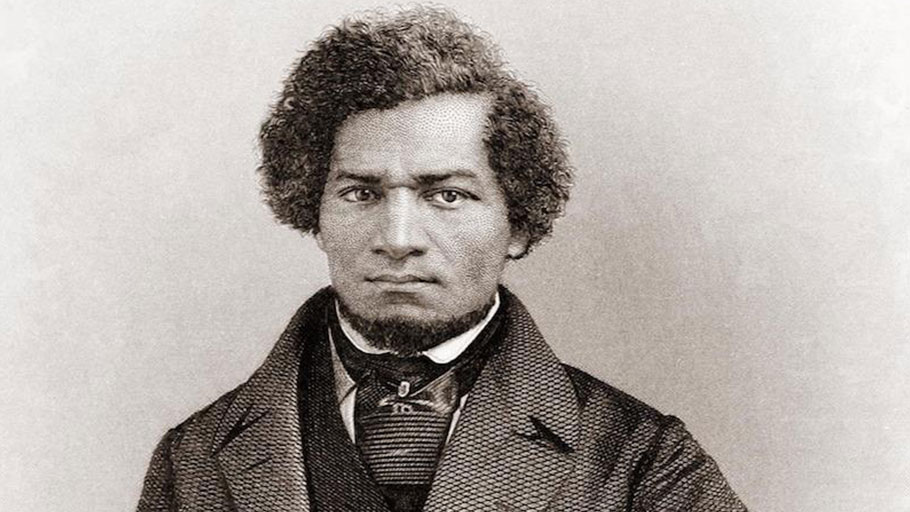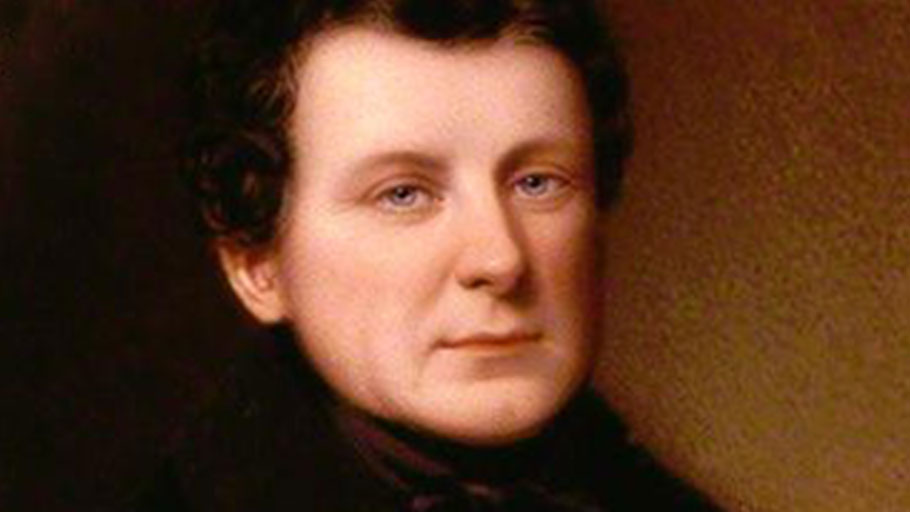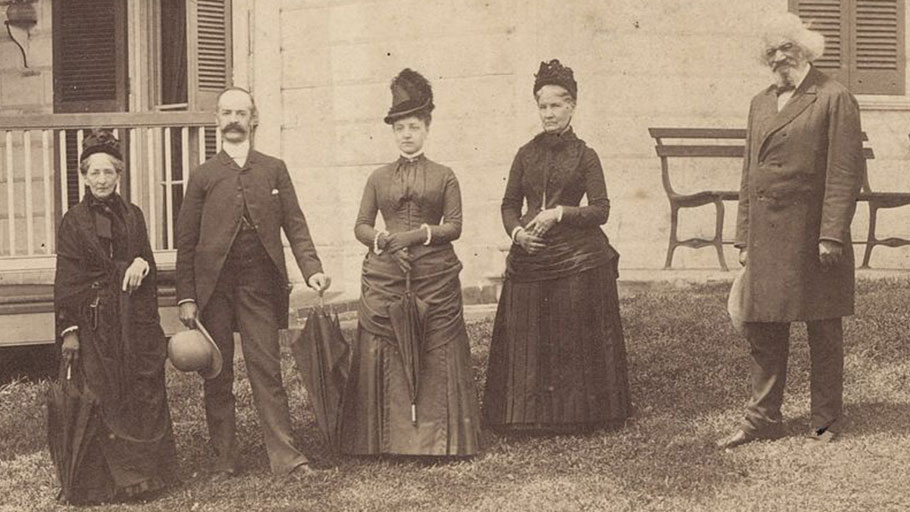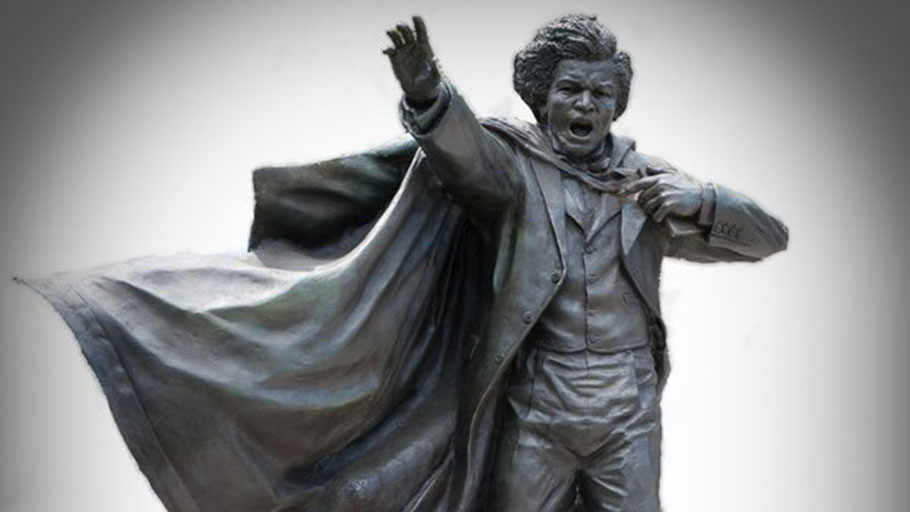Image: A new statue (2015) of Frederick Douglass stands in Hornbake Plaza.
Note: While most of us generally think about the profound activism and wisdom of Frederick Douglass being acknowledged primarily in the United States, his work and reputation was, in fact, international, as noted below regarding his visits to Ireland. In addition, another aspect of the movement for justice and the abolition of slavery was the British/Irish international support and collaboration with American abolitionists, such as Frederick Douglass, William Lloyd Garrison and others. — Heather Gray
Born a slave, Frederick Douglass died as a champion of human rights, and Ireland played an important role in his political awakening.
By Christine Kinealy, Irish America —
In 1845, Ireland provided a safe refuge to Frederick Douglass, a 27-year-old “fugitive” slave from America. Douglass described his four months in the country as the “happiest times” in his life and the Irish people as the most “ardent” abolitionists that he had ever encountered. His stay in Ireland also proved to be “transformative” because, for the first time in his life, Douglass felt that he was being treated “like a man and not a color.”
Douglass never forgot his sojourn in Ireland and the kindness shown to him. Moreover, his Irish experiences and encounters helped to shape his subsequent political development, including his support for Irish independence. What steps led Douglass to Ireland and to his involvement in the so-called “Irish Question” ?
Frederick Bailey was born into slavery in Maryland in 1818 although, as was common amongst slaves, he never knew his actual birthday. When only a teenager, he determined to escape from bondage, finally doing so when aged 20. Upon arrival in New York in 1838, he married Anna Murray, a free black woman who had helped him to escape. Shortly afterwards, he changed his surname to Douglass.

Frederick Douglass
Unlike thousands of other runaway slaves who chose to migrate to Canada, Frederick and Anna settled in the Quaker port of New Bedford. This decision was based on Douglass’s determination to give his support to the abolitionist movement in America. This was not without risk. Even though he was residing in one of the so-called Free States, the Fugitive Slave Act of 1793 meant that Douglass was in constant danger of being seized and returned to his “master.”
In 1841, Douglass spoke at an abolitionist meeting in Nantucket, where he was heard by the founder of the American Anti-Slavery Society, William Lloyd Garrison. Like the rest of the audience, Garrison was mesmerized by the runaway slave’s compelling life-story and his powerful oratory. He offered Douglass a position as a lecturer with his organization. Douglass accepted although he knew the danger of being in the public eye. The publication of Douglass’s best-selling life-story, the “Narrative” in May 1845 propelled him to the forefront of the abolitionist movement. It also greatly increased the likelihood of his being captured. Douglass was persuaded to travel to Britain, where he would be safe and where he could promote the work of the American Anti-Slavery Society. He agreed reluctantly, leaving his wife and four small children behind while he made a journey into the unknown.
Douglass sailed from Boston to Liverpool in August 1845. Because of his color, he was forced to travel in steerage, despite the purchase of a first-class ticket. Two days following his arrival in Liverpool, Douglass sailed to Dublin to meet with a Quaker printer, Richard Webb, who had offered to print an Irish version of his “Narrative.” Upon landing in Ireland, Douglass immediately wrote to his mentor, Garrison, that he was now “safe in old Ireland.” He intended to spend only four days in the country, but the warmth of the welcome meant that he stayed for four months, lecturing on abolition in Dublin, Wexford, Waterford, Youghal, Cork, Limerick, and Belfast.
Douglass’s visit coincided with a struggle for Irish independence taking place. Even before arriving in Ireland, Douglass knew of Daniel O’Connell and of his role in winning Catholic Emancipation. More significantly, he was also aware of O’Connell’s vociferous championing of abolition and his unequivocal defense of black people as being the equal of whites. On September 29, 1845, Douglass attended a Repeal meeting in Dublin. At the end of the meeting, Douglass was invited on stage by O’Connell, who asked him to address the audience. It was during this impromptu speech that Douglass stated that his people needed a “Black O’Connell” to lead them to freedom. His comment was to prove prophetic.

Daniel O’Connell, who greatly influenced Frederick Douglass
Douglass was aware that Ireland, its poverty, its people, and their passionate defence of abolition had changed him, writing to Garrison:
I see much here to remind me of my former condition, and I confess I should be ashamed to lift up my voice against American slavery, but that I know the cause of humanity is one the world over. He who really and only feels for the American slave, cannot steel his heart of the woes of others; and he who thinks himself an abolitionist, yet cannot enter into the wrongs of others, has yet to find a true foundation for his anti-slavery faith.
Douglass left Ireland in January 1846 and from there he traveled to Scotland and then on to England to continue with what was increasingly his “lonely pilgrimage”. Douglass finally returned to the U.S. in April 1847, and as a free man, his “freedom” having been purchased by women abolitionists in England.
The agency and independence that Douglass had experienced while in exile were immediately evident as soon after arriving home, he moved his family to Rochester and launched his own abolitionist newspaper, The North Star. Garrison disapproved of both actions. In 1848, Douglass attended the Seneca Falls Convention where he was one of a handful of men, and the only black man, to sign the Declaration of Sentiments. Over the subsequent decades, Douglass would continue to agitate for abolition, and, following the Civil War, for equality for his people. But, as he had realized in Ireland, the cause of his people was part of his larger quest for social justice for all.
In 1886, Douglass decided to return to Europe, to revisit the people and places that had welcomed him forty years earlier. Unlike then, he now travelled as an American citizen who was allowed to sail in first class. At the end of his one-year journey, Douglass travelled to Ireland. He did so because he wished “to once more look into the faces and hear the voices of the few remaining friends who gave me sympathy and support during my visit 41 years ago.” Sadly, all of his Irish hosts were now dead. He met with their children, however, and in Dublin stayed with Alfred Webb, son of Richard and a Quaker nationalist.
Douglass’s second visit to Ireland coincided with another struggle for independence taking place, the constitutional Repeal movement of the 1840s having been succeeded by another peaceful political movement known as Home Rule. Widespread agitation, spearheaded by Charles Stewart Parnell, had resulted in the introduction of the Government of Ireland Bill, more popularly known as the First Home Rule Bill, in April 1886. It was introduced by the Liberal Prime Minister, William Gladstone, but it failed to be passed by the Westminster Parliament. To oppose the Home Rule movement, the Irish Loyal and Patriotic Union had been founded in Dublin in 1885. The intrepid Douglass inserted himself into this political cauldron.
Douglass would have encountered the Home Rule movement and its supporters in America. The Irish demand for independence divided African-American opinion in the 1880s. This was largely due to the fact that the Irish in America had been weak on, or opposed to, abolition before the Civil War, and a number were racists, as the New York Draft Riots of 1863 had demonstrated. Douglass, however, had always made a distinction between the Irish in Ireland and the Irish in America. In 1886, he had written to the Boston Pilot stating that he had “never allowed the unfriendly attitude of Irish men in this country toward colored people to dim my vision as to the just rights of Irishmen at home.”
Before sailing to Europe, Douglass publicly demonstrated his sympathy with the Home Rule agitation in Ireland and with William Gladstone, the English politician who was giving support to it, at an abolitionist dinner in Boston, he told his audience:
I shall remember your injunction to extend your sympathy to all men oppressed; and I shall not hesitate to declare my own entire sympathy with that grand old man, Mr. Gladstone, in his endeavors to remove the reproach of oppression from England and to extend the desired liberty to Ireland.

Frederick Douglass in Ireland in 1880s
In 1886 also, Douglass published an 18-page article entitled “Thoughts and Recollections on Ireland.” In it, he reflected on his first visit to the country and on Ireland’s continuing poverty and colonial status. He described the country as “the land of Burke and Sheridan, of Grattan and Curran, of O’Connell and Father Matthew [sic]; a land renowned in song and story for its statesmen, orators, patriots, and heroes, but alas! a land which has been for ages the scene of misrule and social misery….” Again, Douglass praised Gladstone for being the first British statesman who had attempted to resolve the issue. Pointing to the success of the Irish overseas, he stated, “Irishmen are said to rule everywhere except in Ireland.” Douglass concluded the article by saying:
I have favored ‘Home Rule’ for Ireland for two reasons: First, because Ireland wants ‘Home Rule,’ and Secondly, because it will free England from the charge of continued oppression of Ireland… I am for fair play for the Irishman, the negro, the Chinaman, and for all men of whatever country or clime, and for allowing them to work out their own destiny without outside interference.
Douglass’s support for Home Rule continued following his return to the U.S. In December 1887, only months after his visit to Ireland, Douglass attended a meeting in Washington in support of Irish independence. Sir Thomas Grattan Esmonde and the Hon. Arthur O’Connor, two Home Rule MPs, attended, as did eight senators and 52 members of Congress. Twenty thousand people had accompanied the speakers to the hall. Douglass, who was part of the platform party, was the final speaker. When he rose to speak, he received “great applause.” Douglass commenced his speech with typical humor, making fun of the fact that he was the only black speaker present and saying he had attended “to give color” to the proceedings. He continued by reminiscing on his first time in Ireland, telling the audience:
More than forty years ago I had the pleasure and the privilege of standing on the banks of the Liffey, side by side with the great Daniel O’Connell (great applause) and at that time I declared, before a vast audience in Conciliation Hall, my conviction of the justice, the wisdom, the necessity, and the final triumph of the repeal of the Union. I heard something of the breadth and comprehensiveness of the Irish heart from that great and good man and I am, therefore, with every other American, of whatever color or class, an out and out Home Ruler for Ireland and an out-and-out Home Ruler for every man in this Republic.
Douglass concluded his speech by linking the rights of black people with those of the Irish saying, “I am here advocating my rights as well as the rights of Ireland.”
One of Douglass’s final public roles was to serve as Consul General to Haiti from 1889 to 1891. His defense and support for the first Black Republic was absolute, refusing to let the US recolonize part of the island for strategic reasons – so instead, they set their sights on Guantanamo Bay in Cuba. In 1893, in a speech defending Haiti, the influence of Ireland was evident, as it had been in so many junctures in Douglass’s life:
It was once said by the great Daniel O’Connell, that the history of Ireland might be traced, like a wounded man through a crowd, by the blood. The same may be said of the history of Haiti as a free state. Her liberty was born in blood, cradled in misfortune, and has lived more or less in a storm of revolutionary turbulence.
Douglass died in February 1895. He was 77 years old, although he passed away without knowing the day or year of his birth. Poignantly, he died following his attendance at a conference for women’s suffrage – a cause that he had championed his whole life. Newspapers in Ireland from the Cork Examiner to the Belfast News-Letter reported his death. Douglass had been born a slave but he died as a champion of international human rights. Ireland had played an important role in his political awakening and just as Douglass never forgot Ireland, Ireland and Irish America have not forgotten Douglass.














